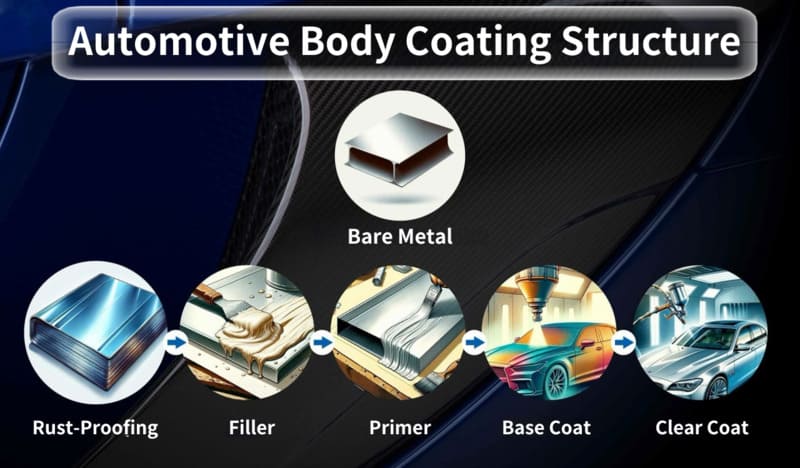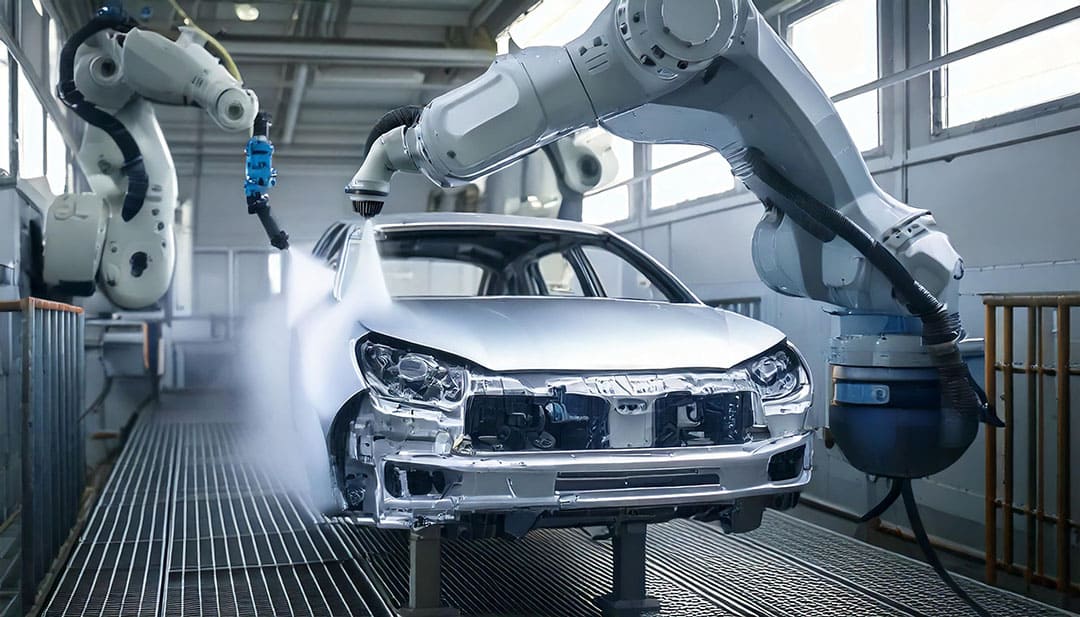1. The Structure of Car Bake Hardening Steel

To understand how to select the right paint for auto body painting, it's essential to grasp the basic structure and techniques involved. The foundation of an automotive paint job is the bottom layer, commonly referred to as the bare metal. Fresh from the factory, this bare metal undergoes cleaning and pre-treatment processes. Following this, a rust-proofing layer is applied to prevent metal corrosion. A filler is also used to smoothen the surface.
Next comes the application of the primer, which serves as a protective layer for the metal and provides a good adhesive surface for the subsequent layers. After the primer, the main color layer, known as the base coat, is applied. This base coat may consist of multiple layers to ensure even color distribution. Finally, a clear coat is layered on top to enhance gloss and protect the base coat layer.
Factory-applied auto body paint assures quality, which is why many used car sellers highlight original factory paint, indirectly indicating that the vehicle hasn't undergone significant repairs or accidents.
In modern vehicle painting, various paint types are used, including acrylic polyurethane enamel with primer, basecoat, and clear topcoat. The painting process has evolved over time, transitioning from manual application requiring weeks to dry to today's method where several coats can dry within hours. Understanding different types of car paints, such as waterborne and solvent-borne systems, is crucial for achieving desired results and maintaining environmental compliance.
[1]
2. Choose the Right Paint - Different Types of Paint
When selecting auto body paint, it's essential to consider the type of paint, its pros and cons, and how to assess the professionalism of paint shops. Here's a comprehensive guide:
Acrylic Polyurethane Enamel: Most modern vehicles use this type, consisting of a primer, basecoat, and clear topcoat. It provides excellent durability and a high-quality finish.
Lacquer: Once a common choice, lacquer is now less favored due to advancements in other paint types that offer better shine and surface protection. It might still be used for restoring antique cars to their original look.
Single-Stage Paint: This paint combines color and gloss in one formula and is typically used on commercial vehicles and trucks. It’s simpler to apply but may offer less depth in the finish compared to multi-stage systems.
Basecoat Clear Coat Paint: A two-stage system that includes a colored base coat followed by a clear coat. It provides a deeper shine and superior protection but is more complex to apply.
Tri-Coat or Multi-Stage Paint: Used mainly for high-end vehicles, this system starts with a base coat, adds a mid-coat with pearls or additives, and finishes with a clear coat for enhanced depth and shine.
Waterborne and Solvent-Borne Systems: Waterborne paints are environmentally friendly and are gaining popularity. Solvent-borne systems are traditional but contain VOCs, posing environmental and health concerns.
[2]
1 ) Choose the Right Paint - Key Considerations
Vehicle Type and Usage: The choice of paint depends on the vehicle type and its intended use. For example, commercial vehicles might do well with single-stage paint, while luxury cars might require tri-coat paint for a more sophisticated finish.
Environmental Impact: Consider environmentally friendly options like waterborne paints, especially in areas where solvent-borne paints are restricted due to their high VOC content.
Desired Finish: If you're seeking a deep, lustrous finish, multi-stage paints like basecoat clear coat or tri-coat systems are ideal. For a simpler, more utilitarian finish, single-stage paint might suffice.
2 ) Choose the Right Paint - Paint Shop Professionalism
Quality of Materials: Professional shops should use high-quality paints tailored for automotive use, as seen in products offered by manufacturers like SYBON, which specializes in a variety of automotive paints and coatings.
Technical Expertise: Look for shops that understand the art and science of auto body painting, including paint chemistry, surface preparation, application techniques, and finishing touches.
Customization and Color Matching: A professional shop should offer extensive color choices and have the technology for precise color matching, ensuring seamless integration with existing paintwork.
Maintenance and Longevity Advice: The shop should provide guidance on maintaining the paint job, including regular washing and applying protective wax or sealant.
Process Transparency: A reputable shop will clearly explain their painting process, step by step, as outlined by Orlando Autobody, which includes determining the paint type, matching the paint, surface preparation, sanding, priming, and finishing
[3]
3. Nozzle Quality Also Impacts Painting Results
Before painting, cars undergo spray-based pre-treatment, where they are cleaned from all angles using nozzles installed on both sides of a track. This process requires nozzles that are easy to install in large numbers, adjustable for spray direction, and simple to maintain.
Generic nozzles often lack precision, leading to uneven spraying and poor paint quality. LORRIC’s clamp nozzles are factory-tested for accuracy within 10%, adjustable for direction, and easy to clean and maintain, ensuring consistent paint finishes.

Case: A Local Painting Equipment Supplier in Taiwan
Situation: This manufacturer specializes in various types of automated painting equipment for iron, aluminum, PVC, and other materials. They offer pre-treatment solutions, paint stripping rooms, and painting booths. Since the 1990s, they have been a prominent supplier of painting equipment to many international brands and industries in Taiwan. Their partnership with LORRIC has exceeded twenty years.
Solution: LORRIC Clamp-On Nozzles
Clamp-on nozzles consist of a three-part structure, including the nozzle, base, and nut. They are easy to install without the need for tools, offer adjustable spray directions, and are convenient for maintenance and cleaning, reducing the cost of nozzle replacement. Additionally, with over 30 years of nozzle manufacturing experience, LORRIC's nozzles provide consistent and even spray distribution, surpassing generic nozzles in quality and effectively enhancing end-user machine performance.